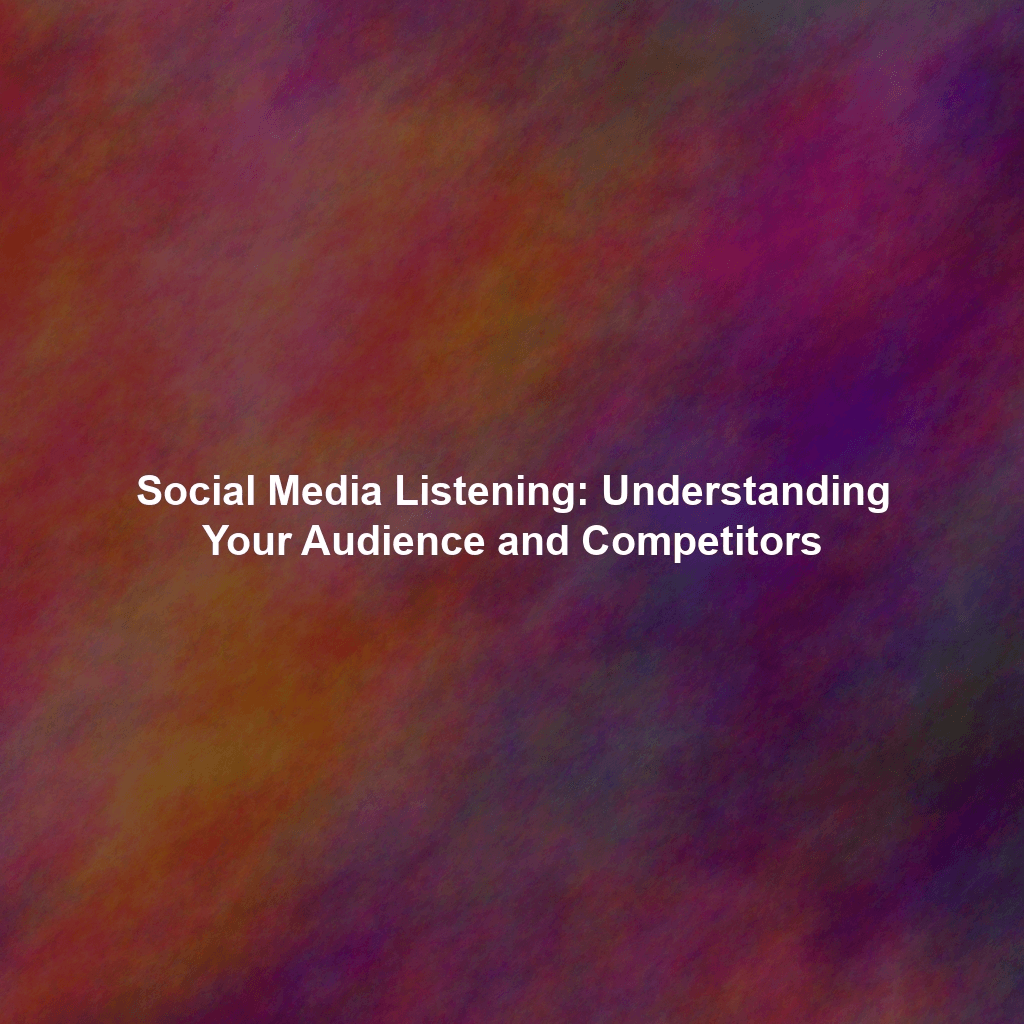In today’s dynamic digital landscape, simply posting content and hoping for engagement is no longer enough. To truly connect with your audience and stay ahead of the competition, you need to actively listen. That’s where social media listening comes in. It’s a powerful marketing strategy that allows you to monitor online conversations, analyze trends, and gain valuable insights into your audience and competitors. Think of it as having your finger constantly on the pulse of the internet, enabling you to make data-driven decisions that drive real results.
What is Social Media Listening?
Social media listening goes beyond just tracking mentions of your brand name. It involves monitoring various social media platforms, forums, blogs, and other online sources for keywords, hashtags, and topics related to your brand, industry, competitors, and target audience. By analyzing these conversations, you can uncover valuable insights into customer sentiment, emerging trends, and competitive strategies.
Social Media Monitoring vs. Social Media Listening
It’s important to differentiate social media monitoring from social media listening. Monitoring focuses primarily on tracking brand mentions and responding to direct inquiries. Listening, on the other hand, is a broader, more strategic approach that involves analyzing the context and sentiment behind those mentions to gain deeper insights.
Why is Social Media Listening Important for Marketing?
Social media listening offers a multitude of benefits for marketers. Here are just a few:
- Understand Your Audience: Discover what your audience is talking about, their pain points, their preferences, and their needs.
- Track Your Brand Reputation: Monitor mentions of your brand to identify potential PR crises, address customer concerns, and improve your brand image.
- Identify Emerging Trends: Stay ahead of the curve by identifying trending topics and conversations in your industry.
- Analyze Competitor Strategies: Track your competitors’ online activities, identify their strengths and weaknesses, and learn from their successes and failures.
- Improve Customer Service: Proactively identify and address customer complaints and issues before they escalate.
- Inform Content Creation: Create content that resonates with your audience by addressing their specific interests and needs.
- Measure Campaign Effectiveness: Track the performance of your marketing campaigns by monitoring social media conversations and sentiment.
How to Implement a Social Media Listening Strategy
Implementing a successful social media listening strategy involves several key steps:
1. Define Your Goals
What do you want to achieve with social media listening? Are you looking to improve customer service, identify new product opportunities, or track your brand reputation? Clearly defining your goals will help you focus your efforts and measure your success.
2. Choose the Right Tools
There are many social media listening tools available, each with its own strengths and weaknesses. Some popular options include:
- Brandwatch: A comprehensive platform with advanced analytics and reporting capabilities.
- Sprout Social: A user-friendly tool with social media management and listening features.
- Hootsuite: A popular platform with social media scheduling and listening tools.
- Mention: A simple and affordable tool for tracking brand mentions.
- Google Alerts: A free tool for monitoring web mentions of your brand and keywords.
Choose a tool that fits your budget and meets your specific needs.
3. Identify Relevant Keywords and Hashtags
Create a list of keywords and hashtags related to your brand, industry, competitors, and target audience. Be specific and include variations of your brand name, common misspellings, and related terms.
4. Monitor Relevant Platforms
Focus your efforts on the platforms where your target audience is most active. This may include Facebook, Twitter, Instagram, LinkedIn, YouTube, and other niche platforms.
5. Analyze the Data
Don’t just collect data; analyze it. Look for patterns, trends, and insights that can help you improve your marketing strategy. Pay attention to sentiment analysis, which can help you understand how people feel about your brand and products.
6. Take Action
Use the insights you gain from social media listening to take action. Respond to customer inquiries, address complaints, create relevant content, adjust your marketing campaigns, and improve your products and services.
Best Practices for Social Media Listening
- Be Proactive: Don’t wait for a crisis to start listening. Regularly monitor social media conversations to identify potential issues before they escalate.
- Be Responsive: Respond to customer inquiries and complaints in a timely and professional manner.
- Be Authentic: Engage in genuine conversations with your audience. Don’t just try to sell them something.
- Be Ethical: Respect privacy and avoid using social media listening to stalk or harass individuals.
- Continuously Improve: Regularly review your social media listening strategy and adjust it as needed.
The Future of Social Media Listening
Social media listening is constantly evolving, with new technologies and techniques emerging all the time. Artificial intelligence (AI) and machine learning are playing an increasingly important role in analyzing social media data and identifying actionable insights. As social media platforms continue to evolve, social media listening will become even more critical for marketers who want to stay ahead of the curve.
Conclusion
Social media listening is a powerful tool that can help you understand your audience, track your brand reputation, and improve your marketing strategy. By implementing a comprehensive social media listening strategy, you can gain valuable insights that will give you a competitive edge in today’s dynamic digital landscape. So, start listening today and unlock the power of social intelligence for your business.
 Skip to content
Skip to content

